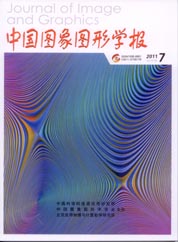
局部自适应混合模型的遥感图像去噪算法
王相海1,2, 李放1, 宋传鸣3,4(1.辽宁师范大学计算机与信息技术学院,大连 116029;2.南京大学计算机软件新技术国家重点实验室,南京 210093;3.辽宁师范大学计算机与信息技术学院,大连 116029;4.南京大学计算机科学与技术系,南京 210093) 摘 要
遥感图像的噪声分析和去除作为经典问题一直受到关注并成为遥感图像处理的一个重要研究领域。传统的去噪方法在一定程度上可以去除图像中的噪声,但往往在去噪的同时会使图像的边缘和细节信息模糊化。针对P-M模型在去除遥感图像高斯噪声时所存在的对图像强边缘和细节附近的噪声难以去除,以及ROF模型通常会导致平坦区域出现“假边缘”,甚至会产生块状效应等问题,提出一种基于局部自适应的混合模型。该模型针对图像局部区域所包含纹理信息的不同,自适应地调整约束权函数,使模型在平滑局部区域能更多地发挥P-M模型的特点,而在纹理丰富或边缘区域则更多地发挥ROF模型的特性,使模型在有效地去除高斯噪声的同时,很好地保护了遥感图像中的边缘特征和细节纹理信息。实验结果表明,对相同的高斯噪声所提出的混合模型去噪后图像的SNR较P-M和ROF模型分别提高了3dB和2dB。
关键词
Remote sensing image de-noising based on local adaptive mixture model
() Abstract
As a typical issue, the noise analysis and elimination of remote sensing images have attracted considerable attention, and become an important research field for remote sensing image processing. Although traditional de-noising methods can eliminate noises to some extent, the edges and details of image are usually blurred while eliminating noise. In addition, the classical P-M model cannot effectively remove the Gaussian noise near strong edges and details, while ROF model tends to produce fake edges even jaggies in smooth region. This paper proposes a local adaptive mixture model to address the issue. According to texture characteristics of an image’s local region, our model can adaptively adjust a weighting function. By this way, our model exploits the advantages of the P-M model in smooth local region, and the advantages of the ROF model in the region with rich textures or edges. This facilitates our model to effectively eliminate Gaussian noise, and at the same time well protect the edge features and details of remote sensing image. Experimental results show that our model gains 3dB and 2dB higher SNR than the P-M model and the ROF model do separately.
Keywords
|



 中国图象图形学报 │ 京ICP备05080539号-4 │ 本系统由
中国图象图形学报 │ 京ICP备05080539号-4 │ 本系统由